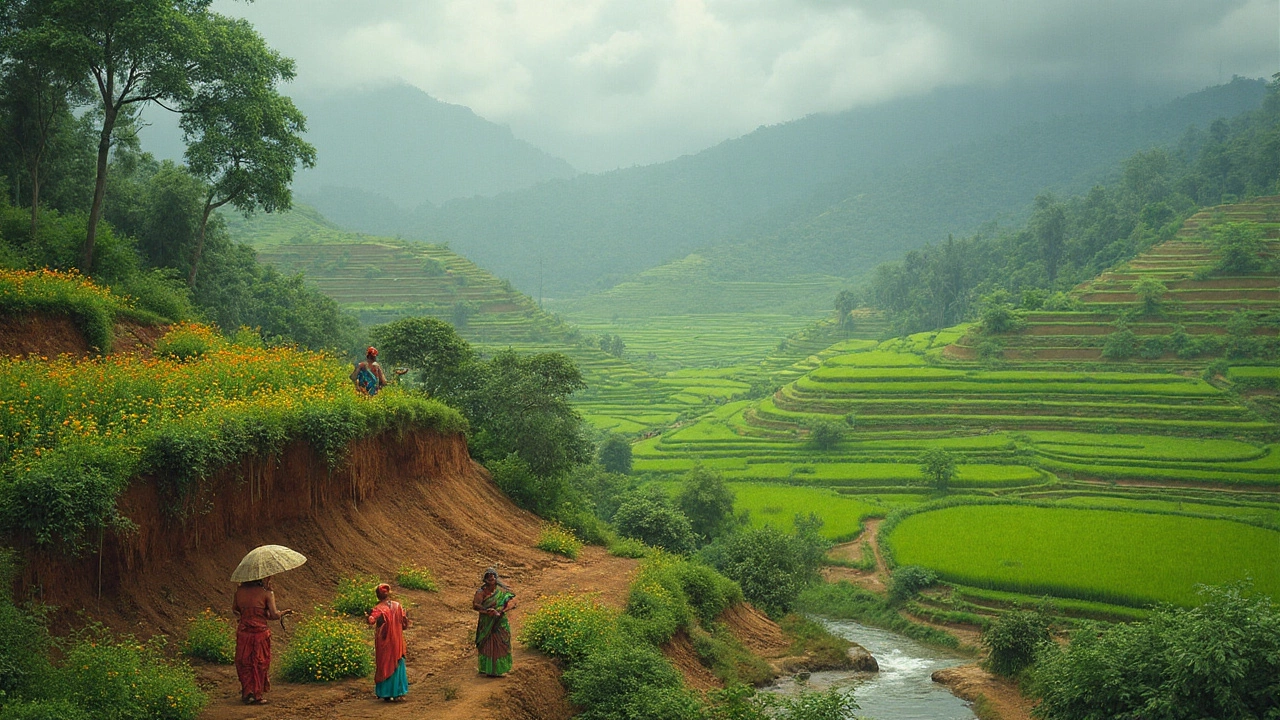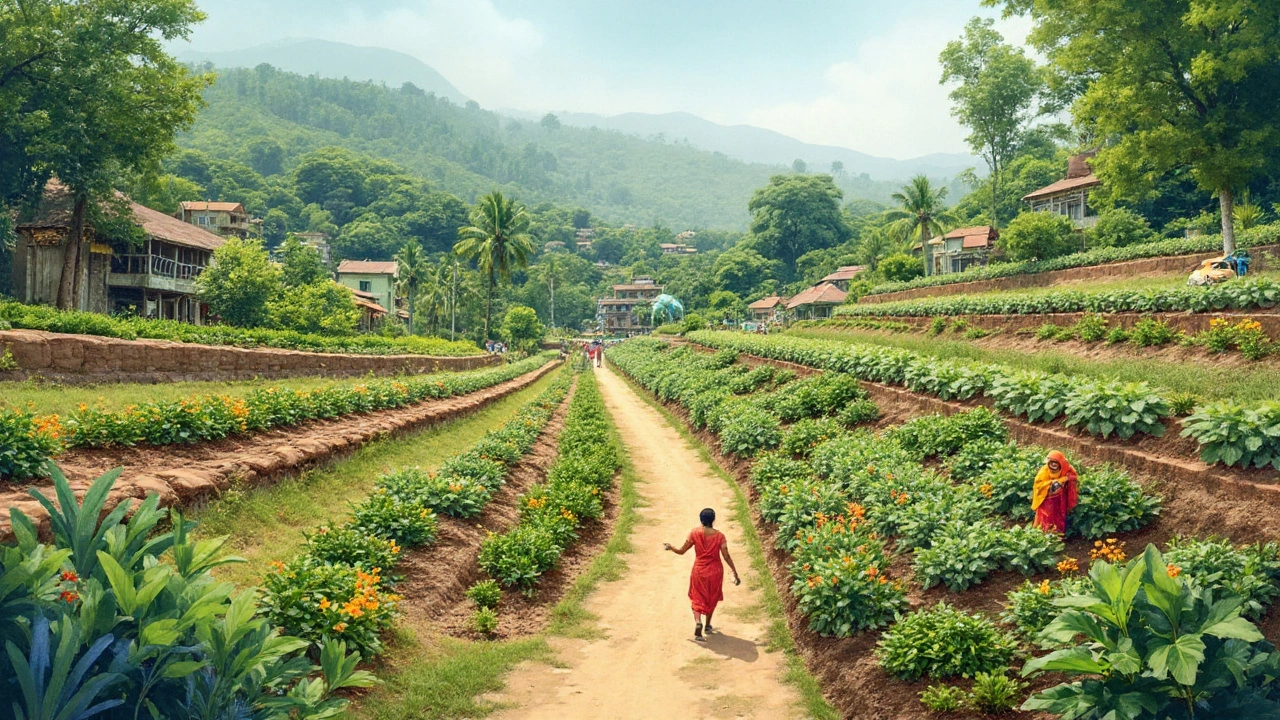If you’ve ever stood on a sloped piece of land during a rainstorm and watched the water rush down, taking valuable soil with it, you’ll get why gardeners are so obsessed with swales and terraces. These aren’t just fancy landscaping ideas—they’re tools that can either make your gardening dreams come true or let your topsoil wash away in a flash. The difference between the two might seem subtle, but it’s actually pretty major if you want to keep your garden productive and the soil right where it belongs. And honestly, plenty of people mess this up, so let’s get this stuff sorted once and for all.
What is a Swale? The Art of Guiding Water
A swale isn’t just a ditch. It’s a game-changer for people dealing with sloped yards, heavy rainfall, or constant erosion. Swales are shallow, usually gently sloping channels dug into the landscape, designed to slow down and redirect rainwater. But don’t imagine an ugly scar in your garden—think more of a subtle, grassy dip or even a flower-filled trench. The main goal here is to capture water as it moves across the land and give it time to soak in, instead of letting it charge downhill and carry precious soil with it.
These water-hungry trenches have a simple science behind them. When water hits a hard, fast slope, it flows like a river and pulls anything loose along for the ride. A swale, built level across the land (on contour), disrupts that flow. Water slows down, spreads out, and ponds for a bit before soaking right into the ground. What’s wild is how much water a swale can hold and distribute underground: even one that’s just one foot deep and ten feet wide will help recharge groundwater faster than you’d expect.
Swales are popular in permaculture, a super practical system of sustainable design. Experts like Geoff Lawton love swales because they “turn an erosion event into an infiltration event,” which basically means less water is wasted and more sticks around where you need it. They work best if you’re in an area with definite slope and decent rainfall, but they aren’t magic wands for every property—on really flat or overly compacted grounds, swales might not help much and could even get swampy.
Check this fun fact: Modern studies tracking swales in suburban neighborhoods have found up to 60% more stormwater can be absorbed compared to not using them at all. Still, not all swales are created equal. Some are filled with gravel, some are mulched, and others come lined with robust plants. The goal is to blend into your landscape, not fight it. If you’re adding shrubs or wildflowers on the downhill side (the "berm") you can boost the amount of water that gets intercepted and the wildlife value, too.
People often ask how deep they should dig a swale. As a rule of thumb, the steeper the slope and heavier the rain, the bigger you need to go. But go too deep and you’ve actually created a ditch—not a swale. The edges should still be broad enough to mow over, or at least, not create a drama for anyone walking nearby. In practice, gardeners will often use hoses filled with water or a level to mark the contour before digging, so the whole feature remains dead level along the landscape.
Swales aren’t just about moving water. They can also form the "bones" of a whole garden system, channeling moisture to thirsty trees and away from foundation walls or soggy pathways. Compared to terraces, swales are less about building up the soil on a step, and more about holding water momentarily before it moves downslope in a much friendlier way.
| Feature | Swale | Terrace |
|---|---|---|
| Main Purpose | Slow and spread water runoff | Level planting area, prevent erosion |
| Shape | Shallow ditch on contour | Flat step or platform |
| Soil Movement | Little displaced, berm created with dug soil | Major earthworks to create flat steps |
| Where Used | Moderate slopes with rainwater | Steep slopes worldwide |
| Plants | Often supports water-loving trees or shrubs | Wide variety of crops, even veggies and grains |
What is a Terrace? Creating Steps for Stability
Picture those dramatic rice paddies climbing up hillsides in China or Southeast Asia. That’s a terrace in action—manmade, flat platforms built into a slope. Terraces are all about giving you stable ground to work on, sometimes where nothing but a goat could stand before. They’re a solution as old as farming itself, popping up everywhere from Incan ruins in Peru to vineyards in Italy.
Terracing is much more work up front than swales. You’re cutting into the side of a hill and moving hefty amounts of dirt to create a wide, level area supported by a vertical face (called a riser or "wall"). In many cases, that wall is made of rocks, timbers, or even living hedges, holding the soil back and preventing it from collapsing. If you look at a cross-section, you’re literally turning a slope into a staircase made of earth.
There’s huge practical value to this, especially if you want to plant crops that just can’t handle slanted ground. On a terrace, your precious water stays put for longer, the soil doesn’t slide away in storms, and you can even maneuver a wheelbarrow comfortably. Crop yields on good terraces can be dramatically higher than on untreated slopes. Some university research out of Vietnam found terraced fields supported as much as 50% more crop yield, purely because water stayed put and soils stuck around for another season.
A cool thing about terraces is their flexibility. While some are huge and labor intensive, smaller ones can fit into a backyard pretty easily, especially if you’re growing herbs or vegetables on an incline. You don’t have to haul stone—wood, recycled bricks, or even woven wattle can hold up a terrace for years. A properly built terrace will last decades with minor maintenance. If you’re in an area with lots of rain, make sure terraces have a tiny tilt backward into the slope so water drains toward the plants and not over the edge, which causes erosion (yep, the very thing you were trying to stop in the first place).
Worth noting: Terraces aren’t usually built on contour like swales. They actually cut a big flat spot into a slope, changing the land’s profile. Some folks combine both systems (swale up top to feed a terrace below), but you’ll want to design carefully in these cases. You don’t want overloaded swales dumping water onto a delicate terrace wall, especially if it’s not reinforced by stone—trust me, mudslides aren’t fun.
“Terracing is one of humanity’s oldest ways to work with the gifts and challenges of sloped land, turning inhospitable hills into abundant fields.” — Dr. John Liu, Ecosystem Restoration ecologist
For homeowners, terracing can also solve issues like mowing nightmares or useless awkward stretches of yard. With each step, think about planting to anchor the soil—deep-rooted grasses, flowers, even edible shrubs. Timber risers need to be rot-resistant (cedar or treated lumber) or you’re just asking for a collapse. And yes, terracing takes up more room than a swale, but sometimes it’s the only way you can get any flat earth to garden on.

Key Differences Between Swales and Terraces
So, you’ve got the basics—one’s a channel for water, one’s a step for soil. But what does that mean when you’re planning your property? For starters, swale is your go-to term if you’re looking at water management on a mild-to-moderate slope, especially if you want to soak water in for trees or reduce flooding risk. Terraces are the answer for steeper slopes, where digging a big flat spot is the only way anything will grow safely at all.
Here’s an easy analogy: swales are like gutters for rain, gently steering water and letting it seep into the landscape. Terraces, on the other hand, are like building a porch on a hill—you get a whole level, stable surface to work on. Swales typically blend into the landscape and are less obtrusive. Terraces can look like strong manmade features because, frankly, that’s what they are—steps carved into the land.
Maintenance is another difference. Swales need occasional weeding, and sometimes reshaping if the berm erodes. Terraces need regular checks on those walls, especially after storms, to make sure the risers or edges haven’t slipped. A poorly maintained terrace can collapse, leading to major repair headaches. As far as cost, swales usually require less labor and cash up front unless you’re going for an extensive redesign. Terraces command more time, money, and sometimes engineering, but pay off if you want to grow crops, set up garden beds, or get access on steep ground.
Climate comes into play, too. If you’re gardening in dry, arid spots, swales are fantastic for catching what little rain you get. On slopes with heavy, frequent downpours, terraces might be safer for major crops, so the soil stays put even under stress. And while you sometimes see both on one property, don’t assume you have to build both—just match the system to your land, your goals, and yes, your workload tolerance.
If you’re worried about appearances, swales can be designed as beautiful features—a lush depression filled with native wildflowers or berries. Terraces, depending on your design chops, can turn a scruffy hillside into a showy stack of little garden rooms. Either way, you’re working with the slope, not against it.
When to Use Swales vs. Terraces: For Your Best Results
Still on the fence? Take a walk around your property on a rainy day. Find out where water gathers and where it escapes. If rainwater sheets off and erodes exposed dirt, swales will help slow things down. Your trees, especially those on the downslope, will thank you. If the ground is so steep it’s tough to stand upright or every time you plant something, it slides away with the next storm, then terraces are probably in your future.
Here’s a quick cheat sheet for which to use:
- Go for swales on gentle-to-moderate slopes where you want to catch and spread rainwater, especially if you’re planting orchards, hedgerows, or rain gardens.
- Opt for terraces on slopes steeper than about 15% (roughly a foot drop every seven feet), or where you want durable, flat gardening spaces for veggies or flowers.
- If you have a long, gradual hill, you might actually use both—start with a swale near the top and terrace below, making sure water never washes directly over a terrace edge.
- If rocks or heavy clay make digging tough, consider low stone-walled terraces instead of deep swales.
Don’t forget the legal side. Major terracing, especially near property lines, can cause neighbor headaches if water begins to flow differently or if a wall fails. Always check for local guidance or hire a pro for big projects—you want your earthworks to last decades, not end up as a cautionary tale on a gardening forum.
On a brighter note, plenty of home gardeners have boosted yields, cut runoff, and even bounced back from “nothing grows here” parts of their yard by picking the right system. Drainage ditches and French drains can move water quickly, but only swales offer rehydration of the soil as a core benefit, making them favorites among folks battling dry spells. Terraces provide the stable, flat ground prized by kitchen gardeners and anyone who wants their landscape to work as hard as they do.

Tips for Building Swales and Terraces Successfully
Let’s get practical for a second—lots of folks make classic mistakes with both swales and terraces. With swales, number one is digging them out of level, so water just piles up at one end (been there, fixed that). Always use a “water level” (clear tubing filled with water) or a builder’s level—don’t eyeball it. You want that swale dead level along its whole length, so water spreads evenly.
If you’re planting on your berm, go for deeply rooting plants—think comfrey or autumn olive for swales. These break up heavy soil with their roots and add organic matter fast. Mulching the swale channels after digging helps prevent weeds and mud. For older houses, don’t run a swale too close to foundations—the last thing you want is a basement flood from your eco-project.
On the terrace front, the number one tip is to plan how you’re going to move dirt, not just where it will end up. Renting a small excavator might sound over the top, but your back will thank you. When you build a riser (the vertical face of the terrace), pack it solid—use rocks, landscape blocks, or stacked logs, but whatever you use, don’t skimp on support. Water that seeps through the soil puts huge pressure on terrace walls during heavy rain, so a skinny riser is a recipe for disaster.
- Swales should be spaced according to slope and rainfall—steeper ground needs swales every 20 to 40 feet; flatter land can handle wider spacing.
- Terraces can be as narrow as three feet for walking or wide enough for a planting bed plus a path. Don’t aim for a single giant terrace; break up a slope with several smaller steps.
- Always compact soil on the new terrace before planting and test the drainage. Flood-prone terraces can be improved by adding gravel or French drains behind risers.
- Monitor both systems after every heavy rain for erosion, water pooling, or slumping edges. Early fixes save way more work down the line.
DIYers can start small—try a five-foot swale in a wet patch, or build a mini-terrace behind a garden shed. The most important step is observing how water moves through your landscape and matching the right tool to the right spot, rather than copying something you saw in a gardening video on a totally different type of land.
Swales and terraces both carry centuries of hands-on wisdom, but they also fit right in with today’s push for more sustainable gardening. Whether you’re trying to save water, grow more food, or just stop the annual mudslide in your backyard, these humble earthworks have your back. Test, tweak, and let your garden show you what works best. If you ever feel lost, just remember: water will always show you where the next change needs to be.

